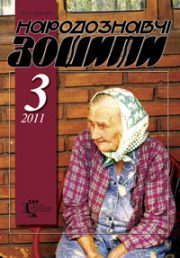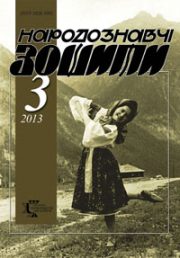The Ethnology Notebooks. 2019, 1 (145), 20—28
UDK 7.031.4.016.4:391-037(477:474.5)
DOI https://doi.org/10.15407/nz2019.01.020
IN THE SEARCH OF ETHNO-ARTISTIC IDENTITY: UKRAINIAN-LITHUANIAN STUDIOS (the second meeting)
FEDORCHUK Olena
ORCID ID: https://orcid.org/0000-0002-4724-3566
PhD in Arts,
Senior Researcher at the Ethnology Institute
National Academy of Sciences of Ukraine,
Folk Art Department
15, Svobody Avenue, 79000, Lviv, Ukraine.
Contacts: e-mail: folena@i.ua
NYKORAK Olena
ORCID ID: https://orcid.org/0000-0003-0887-8929
Doctor in Arts, Professor,
Leading Researcher at the Ethnology Institute
National Academy of Sciences of Ukraine,
Folk Art Department
15, Svobody Avenue, 79000, Lviv, Ukraine.
Contacts: e-mail: olenanykorak@gmail.com
KUMPIKAYT Egle
PhD in Technical Sciences,
Associate Professor at the Kaunas University of Technology,
Faculty of Mechanical Engineering and Design,
Department of Production Engineering
Studentu str. 56, LT-51424 Kaunas, Lithuania
Contacts: e-mail: egle.kumpikaite@ktu.lt
MILAZHENE Diva
PhD in Technical Sciences,
Senior Researcher at the Kaunas University of Technology,
Faculty of Mechanical Engineering and Design,
Department of Production Engineering
Studentu str. 56, LT-51424 Kaunas, Lithuania
Contacts: e-mail: daiva.milasiene@ktu.lt
NENARTAVIИIŪTĖ Erika
Senior Officer at the Museum
Open Air Museum of Lithuania in Rumљiљkės
Contacts: e-mail: erikanort@yahoo.com
Abstract. This paper continues chronicle series dedicated to Ukrainian-Lithuanian interdisciplinary research project «Ornamentation of West Ukrainian and Lithuanian Folk Textile: Universal and Unique Parameters». The results of the second meeting in June 2018, held in the Open Air Museum of Lithuania (Lithuania, Rumљiљkės, Kaishiadoris district), are presented.
Keywords: Ukraine, Lithuania, ethnographic textile, technical ornament, artistic ornament.
Received 29.01.2019
REFERENCES
Fedorchuk, O., Kutsyr, T., Kumpikaitė, E., Milaљienė, D. & Nenartaviиiūtė, E. (2018). In the search of ethno-artistic identity: Ukrainian-Lithuanian studios (the First Meeting). The Ethnology Notebooks, 2, 333—338 [in Ukrainian].
A group of scientists from Lviv visited Lithuania due to international project. (2018, june 19) from the website of the Press service of Lviv City Council: Retrieved from: https://city-adm.lviv.ua/news/culture/251569-hrupa-lvivskykh-uchenykh-u-ramkakh-mizhnarodnoho-proektu-ornamentyka-etnohrafichnoho-tekstyliu-zakhidnoi-ukrainy-ta-lytvy-universalni-i-unikalni-parametry-vidvidala-lytvu [in Ukrainian].
Fedorchuk, O. (2018, june 25) Ukrainian-Lithuanian project «Ornamentation of ethnographic textiles of Western Ukraine and Lithuania: universal and unique parameters» from the website of the National Academy of Sciences of Ukraine: Retrieved from: http://ethnology.lviv.ua/ua/63/novyny_z_jyttya_instytutu.html [in Ukrainian].
The Ukrainian-Lithuanian scientific project continues (2018, june 25) from the website of the National Academy of Sciences of Ukraine: Retrieved from: http://www.nas.gov.ua/UA/Messages/news/Pages/View.aspx?MessageID=4106 [in Ukrainian].
Nykorak, O.I. (2004). Ukrainian folk fabric of the XIX—XX centuries: Typology, localization, artistic features. Part 1. Interior fabrics (based on materials from the western regions of Ukraine) [in Ukrainian].
Nykorak, O.I. (2010). Ukrainian folk patterned fabrics: comparative characteristic. Zapysky naukovoho tovarystva imeni Shevchenka. Lviv. CC CCLIX (259): Pratsi Sektsiyi etnohrafiyi ta fol’klorystyky, 179—210 [in Ukrainian].
Report on research work «Ornamentation of ethnographic textiles of Western Ukraine and Lithuania: universal and unique parameters» for the first stage (2018, july 26). In Archive of the Department of Folk Art of the Ethnology Institute of the National Academy of Sciences of Ukraine [in Ukrainian].
Kumpikaitė, Eglė, & Nėnienė, Inga. (2007). The Diamond Twills in Lithuanian Folk-skirts. Materials science (Medћiagotyra), 1 (Vol. 13, pp. 79—82).
Tomkuvienė, D. (2013). National costume of Kaiљiadorys district. Vilnius: Kaiљiadorys Museum [in Lithuanian].
Fedorchuk, O.S. (2012). Glass-beads in the traditional ukrainian garments (the typology issue). The Ethnology Notebooks, 3, 452—468 [in Ukrainian].
Traditional clothing accessories. Bags, holders, binders, purses, belts, bags (2014). Vilnius: Lietuvos nacionalinis muziejus [in Lithuanian].
Juљkienė, I.F. (2015). From basket to bag. Vilnius: Vilnius Ethnic Culture Center [in Lithuanian].
Juљkienė, I.F. (2008). Rieљinės. Vilnius: Spausdino UAB «Petro ofsetas» [in Lithuanian].






